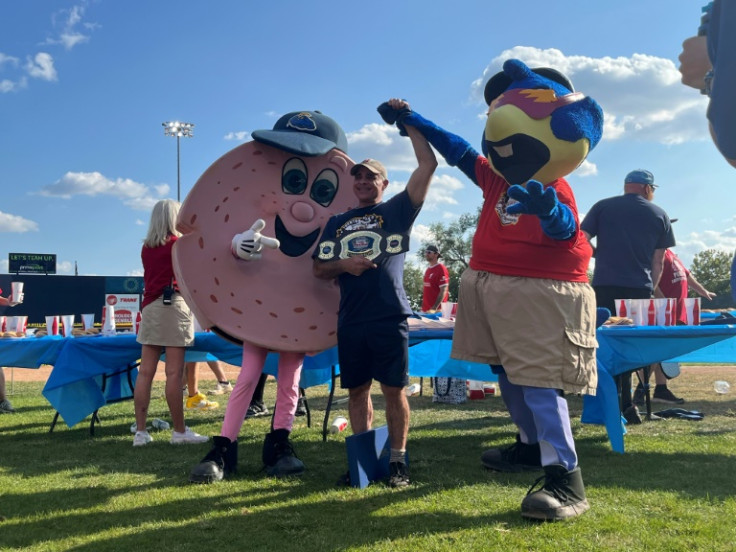Major League Eating: The Sport Of Stuffing Your Face

Each man gobbled up 44 pork rolls in 10 minutes, but it was the last bite that earned one of them the $2,000 top prize in the very American pastime of competitive eating.
The winner, Geoffrey Esper, ate just a bit more of roll number 45 than his closest competitor, sealing his triumph in this chapter of a sport called Major League Eating.
The runner-up, James Webb, said that in most of the contests this year the winner down to the fourth place finisher were separated by "a swallow or a mouthful or a serving size."
The 35-year-old Australian who moved to the United States to compete full-time added, "It's very competitive."
The prize money is nowhere near enough to live on, says Webb, a bearded, healthy-looking man who gets by financially with help from sponsors and his YouTube channel, which has 115,000 viewers.
"Everybody's got another job but Joey," said Crazy Legs Conti, a maitre d' at a New York restaurant who says he has made several thousand dollars this year on the pro-eating circuit.
That Joey is Joey Chestnut, an eating superstar who has won 16 of the last 18 editions of the yearly Nathan's Hot Dog Eating Contest on Coney Island, the Super Bowl of the MLE season.
Because of a problem with a sponsor Chestnut did not take part this year. But he did win $100,000 by beating another competitive eating legend, Takeru Kobayashi of Japan, in a duel organized by Netflix.
Even with Chestnut absent, thousands of spectators gathered on Coney Island in July and around one million watched online as a man named Patrick Bertoletti took the title held by Chestnut and won $10,000 by wolfing down 58 wieners in 10 minutes.
"There's a lot of media coverage. We got more media coverage this year than ever before," said George Shea, a co-founder of Major League Eating. He has visions of expanding overseas, after organizing an event in Thailand.
MLE was created in 1997 and has transformed American eating competitions from something of a joke into high-level events.
Gone are the hulks who used to be common at these bouts and in their place are more slender guys like Kobayashi, who has won the Coney Island competition six times. He weighs about 160 lbs (72 kilos).
Rather than the size of a competitor, what matters more now is technique and how much their stomach can stretch as they eat and eat and eat.
Most MLE contestants train by ingesting large amounts of liquid, a technique that has been widely studied. They also focus on relaxing and mentally visualizing their goal of huge food intake.
"You look at almost all the athletes minus one, they're all in traditional athletic shape. They stay in great shape," said Conti.
Over the course of 30 years, the record for competitive hot dog consumption has ballooned from 21 in 12 minutes to 83 in 10 minutes.
Webb said that after competing he sleeps, hydrates, eats little and is back in shape in 48 hours, without having to induce vomiting.
There is no scientific study showing the health of these food athletes suffers because of what they do.
"My health checks out. I'm in pretty good shape," said Conti, adding that his doctors are not worried about his lifestyle. "They're kind of fascinated by it."
Critics of competitive eating dislike its image, saying it smacks of grotesque over-consumption and eating disorders.
But Angel Ortiz, who came to watch the pork roll eating contest organized earlier this month by a minor league baseball team called the Trenton Thunder, is not worried.
"I just see it as more of a fun thing to do," said Ortiz.
Shea, the MLE cofounder understands "there are all kinds of other issues related to it, and thoughts and concepts."
But, he added: "Generally, this is perceived for what it's supposed to be, which is fun, silly."


© Copyright AFP 2024. All rights reserved.





















